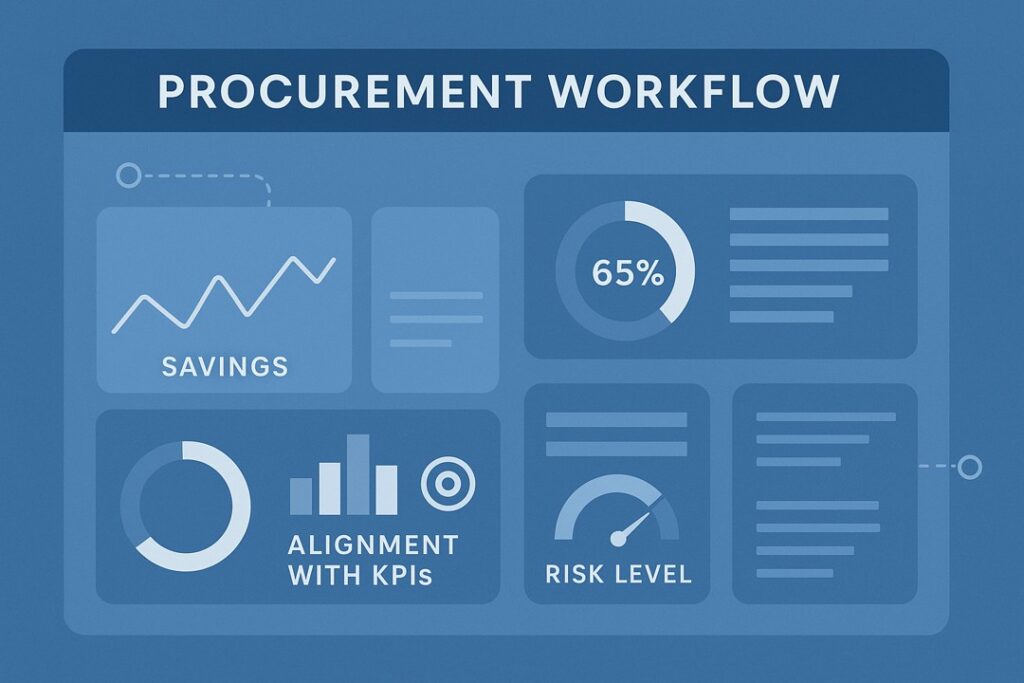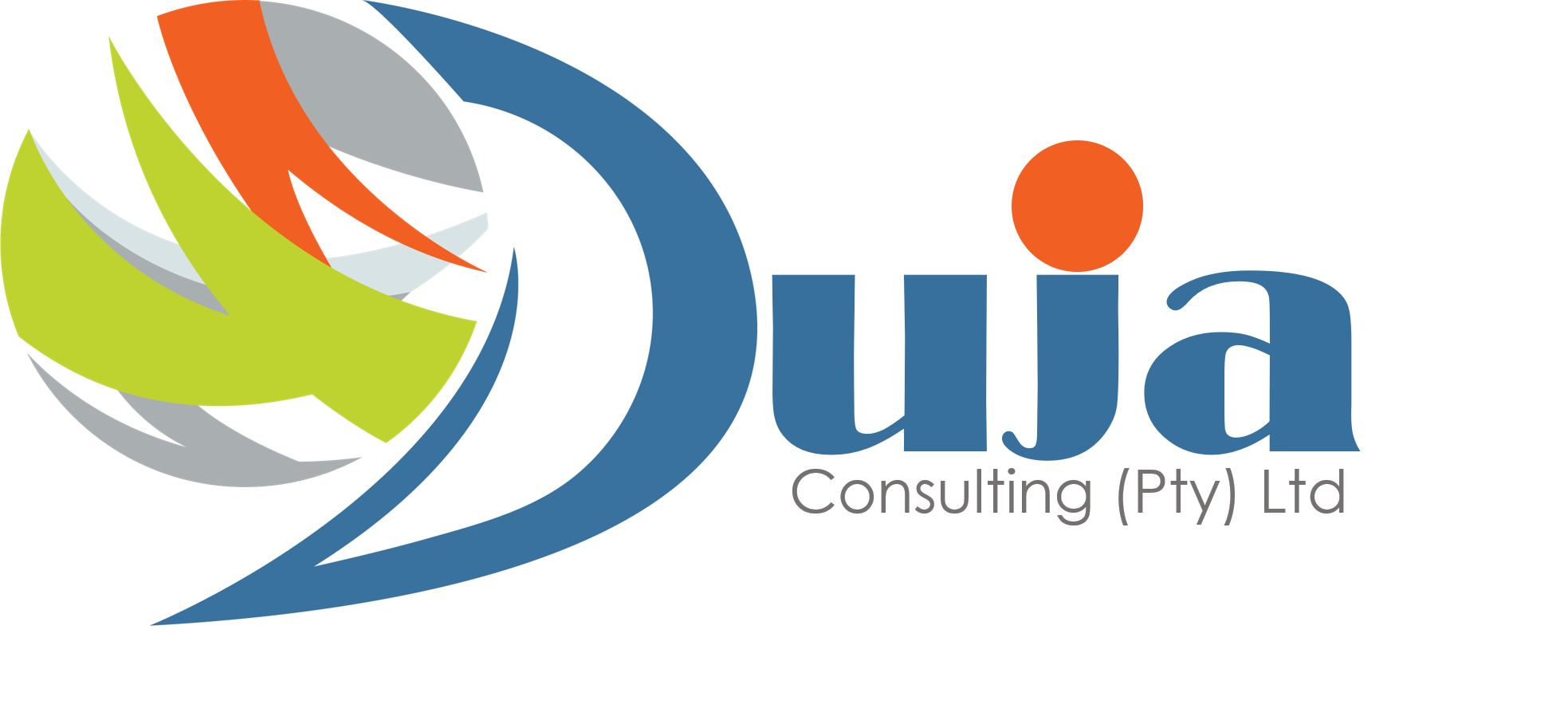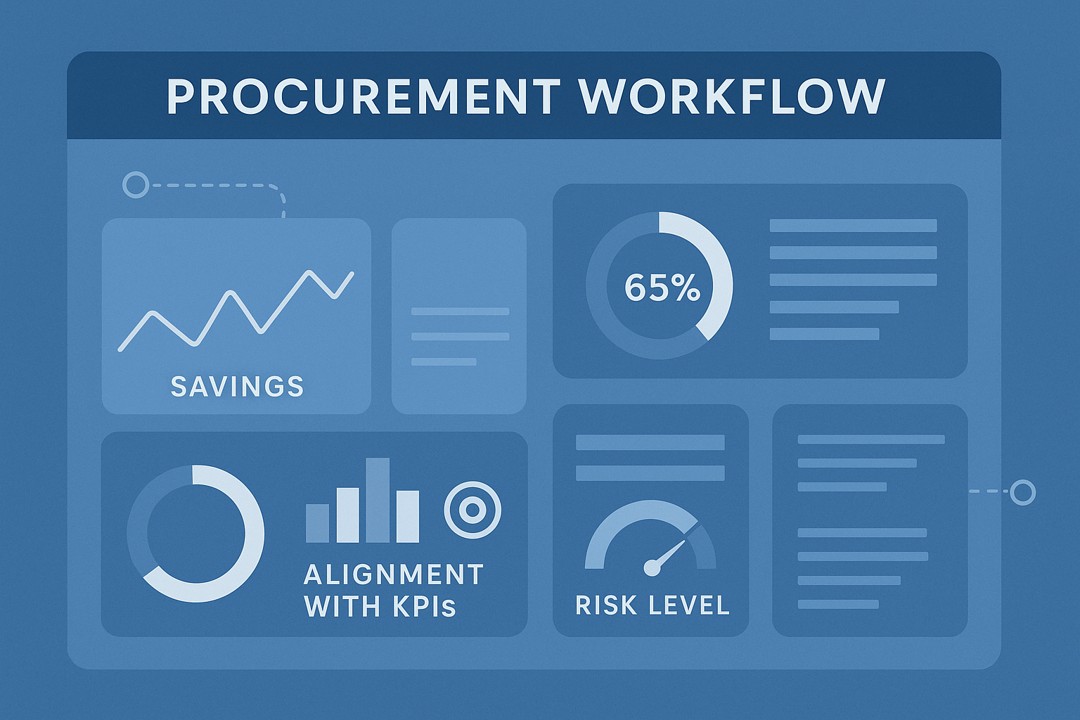Aligning Procurement with Business Goals
Procurement is no longer just about cutting costs. When aligned with business goals, it becomes a powerful driver of growth, efficiency, and innovation.
Our latest paper explores how private companies can:
- Avoid misalignment that drains budgets and wastes resources
- Build procurement strategies that directly support organisational objectives
- Create supplier partnerships that fuel efficiency and innovation
- Transform procurement into a strategic asset

Introduction
Procurement is no longer a back-office, transactional function – it has become a strategic partner in driving business success. In private companies, aligning the procurement strategy with overall business goals is crucial to ensure every pound spent contributes value to the organisation’s objectives. When procurement operates in isolation or pursues conflicting priorities, the result is often inefficiency and wasted resources. This report examines how misalignment between procurement and business strategy leads to resource waste and missed opportunities, and it explores practical strategies to ensure procurement directly supports organisational objectives. A real-world case study from a private company is included to illustrate how strategic alignment in procurement can drive efficiency and competitive advantage. The tone is business-oriented, focusing on actionable insights for a corporate audience.
The Cost of Misalignment between Procurement and Business Strategy
Misalignment between a company’s procurement strategy and its business goals can have serious consequences. When procurement’s priorities do not reflect the organisation’s strategy, inefficiencies and wasted resources are inevitable. For example, if a company’s top goal is to reduce costs but its procurement team is focused on buying premium, high-specification supplies, this disconnect will likely result in unnecessary spending and higher prices. In general, procurement strategies developed in isolation – without considering overall business objectives – lead to “inefficiencies, missed opportunities, and wasted resources.” Key benefits that the business seeks (such as cost savings, speed to market, or innovation) may not be realised if procurement is pulling in a different direction.
One common symptom of misalignment is maverick spending or uncoordinated purchases. When clear organisational priorities do not guide procurement, different departments may make off-contract or non-strategic purchases, leading to duplicated efforts and loss of volume pricing benefits. This fragmented approach undermines efficiency and can inflate costs. Similarly, poor communication between procurement and other departments often causes requirements to be unclear or even conflicting. According to industry analysis, siloed decision-making and a lack of stakeholder alignment result in fragmented supplier relationships and “unrealised savings,” hindering the company’s ability to achieve its broader goals. In other words, a misaligned procurement function often ends up spending money on the wrong things or failing to leverage opportunities that support business strategy.
Misalignment can also erode value in less obvious ways. Procurement teams might celebrate achievements like negotiated savings or supplier consolidation, only to find that those efforts don’t advance what the business currently cares about. A telling example is a Chief Procurement Officer (CPO) proudly reporting cost savings to the Chief Financial Officer (CFO), only to be told that risk reduction – not cost – has been the top priority for the past six months. In such cases, procurement was busy doing “the wrong things” from the business’s perspective, rendering its work less impactful. This not only wastes time and resources, but it also means procurement loses credibility and influence at the executive table. As procurement lags on strategic relevance, the company misses chances to mitigate risks or drive growth as needed.
Ultimately, a lack of alignment leads to inefficient processes and even operational risks. If procurement isn’t working closely with key business units (like finance, operations, or R&D), it may fail to support critical needs – for instance, not sourcing materials for a new product launch on time or ignoring quality and sustainability requirements that are part of the company’s mission. One report notes that historically “procurement has been viewed as a transactional function” separate from other departments. Still, in modern businesses it must take on a strategic role in “mitigating risk and ensuring business continuity.” When it fails to do so, the result can be financial mismanagement and instability for the company. In summary, misalignment between procurement and business strategy wastes money, squanders opportunities, and can even expose the firm to financial and operational risks.
The Need for Alignment and Its Benefits
Aligning procurement strategy with business goals is not just a matter of avoiding waste – it is a proactive way to drive value. When procurement and corporate objectives are in sync, every procurement activity is geared towards supporting the company’s mission, whether that is market expansion, innovation, customer satisfaction or cost leadership. According to best-practice insights, the “foundation of successful procurement transformation lies in aligning the procurement strategy with the overall business objectives.” This ensures that procurement efforts directly support broader goals such as cost reduction, quality improvement and innovation. In practical terms, an aligned procurement function can be a powerful enabler: it secures the right products and services, at the right cost and quality, to fuel the company’s strategic initiatives.
The benefits of alignment manifest in multiple ways. First, efficiency gains are significant. Aligned procurement eliminates redundant spending and streamlines purchasing processes according to what the business truly needs. Companies often experience reduced lead times and lower inventory costs because procurement works hand-in-hand with operations to manage supply and demand effectively. For instance, Toyota’s renowned procurement approach is tightly integrated with its production strategy – using just-in-time principles to eliminate excess inventory and waste. Toyota’s procurement system is designed to deliver “what is needed, when it is needed, and in the amount needed,” minimising unnecessary stock and maintaining high efficiency. This alignment of procurement with the Toyota Production System has contributed to Toyota’s ability to operate with very low waste and outstanding operational efficiency.
Second, aligned procurement drives cost savings and value beyond basic price reductions. When procurement knows the company’s financial targets and innovation goals, it can negotiate and structure supplier relationships to meet those targets. A study by Direct Sourcing highlights that engaging stakeholders across the organisation to set procurement priorities results in initiatives that are strategically focused on value, rather than ad-hoc buying. In one case, a private manufacturing company under new ownership refocused its procurement to align with the owners’ objectives, optimising areas like tail-end spend and maintenance purchasing. The result was significant cost savings, including a 16% saving on low-volume (“tail end”) items and 27% savings on Maintenance, Repair and Operations (MRO) sourcing. These tangible benefits arose because procurement was steered to directly support the new business goals (in this case, improved cost efficiency and return on investment).
Third, alignment elevates procurement’s role to that of a strategic contributor, which improves accountability and agility. When procurement KPIs mirror business KPIs, it creates accountability that procurement will deliver not just on its own functional metrics but on the company’s success metrics. For example, if an organisation prioritises customer experience, an aligned procurement team might emphasise supplier quality and reliability (not just cost), thereby supporting the goal of customer satisfaction. If innovation is a strategic priority, an aligned procurement function will seek out cutting-edge suppliers and foster supplier partnerships that contribute to product development. Unilever, for instance, aligns its procurement closely with its sustainability and innovation objectives. The company’s procurement strategy prioritises suppliers who share its values and standards, moving away from treating vendors simply as low-cost providers and towards viewing them as partners in agile, innovative business practices. This alignment with organisational values not only helps Unilever meet its sustainability targets but also opens opportunities for innovation and competitive differentiation.
Moreover, alignment helps avoid risks and build resilience. When business goals shift (e.g. towards risk reduction, scalability, or sustainability), an aligned procurement function can adjust its sourcing and supplier management accordingly – in lockstep with the business. This adaptability was underscored during recent global disruptions, where companies with aligned, strategic procurement teams managed to secure supplies and control costs better than those with siloed purchasing units. In short, aligning procurement with business goals turns procurement into a lever for executing strategy: it ensures resources are used wisely, amplifies the impact of every supplier relationship, and helps the company achieve its objectives more effectively.
Practical Strategies to Align Procurement with Organisational Objectives
Aligning procurement and business strategy requires deliberate action and cross-functional coordination.
Below are practical strategies private companies can implement to ensure procurement directly supports organisational objectives:
1. Integrate Procurement into Strategic Planning:
Procurement should have a seat at the table during business planning and goal-setting sessions. By involving procurement leaders in discussions about corporate strategy, companies ensure that procurement understands the “needs and priorities” of the business and can plan accordingly. When a new business strategy or annual plan is formulated, procurement must translate that into a supporting sourcing plan. For example, if the business strategy emphasises rapid market expansion, the procurement team should be planning how to source additional capacity or find suppliers in new regions to enable that growth. Early involvement prevents the common problem of procurement working on outdated or secondary objectives. It also allows procurement to flag supply market challenges or cost implications up front, resulting in more realistic and aligned business plans.
2. Align Procurement KPIs with Business Goals:
It is critical to measure what matters. Companies should review and adjust procurement’s performance metrics so that they reflect organisational goals. If the business prioritises cost leadership, then procurement KPIs might emphasise year-on-year cost reduction, spend under management, and avoidance of maverick spend. If innovation or time-to-market is a priority, then metrics like speed of procurement cycle, new supplier onboarding time, or supplier-enabled innovation count more. The key is that every major procurement KPI should map to a business objective. This alignment sends a clear message to the procurement team: their success is measured by how well they support the company’s success, not just by isolated procurement efficiencies. It also incentivises the right behaviours – for instance, a procurement manager will be less likely to choose a supplier solely on the lowest price if there is also a KPI around supplier quality or risk that ties into a broader goal.
3. Improve Cross-Functional Communication and Collaboration:
Breaking down silos between procurement and other departments is essential for alignment. Lack of stakeholder alignment is “one of the most disruptive issues” in strategic procurement, leading to conflicting priorities and delays. To counter this, organisations can establish regular communication channels and joint planning sessions between procurement and key departments such as Finance, Operations, IT, and Sales. For example, a virtual category council or cross-functional procurement committee can be formed – bringing together procurement category managers and business unit leaders to set shared priorities and make decisions collaboratively. Through such forums, procurement gains visibility into upcoming projects and demand forecasts, while business units gain appreciation for procurement’s value offerings. Effective tools include stakeholder mapping and clear RACI (Responsible, Accountable, Consulted, Informed) matrices for procurement projects. When all parties understand each other’s goals, procurement can act in concert with other teams. A direct benefit is quicker decision-making and fewer last-minute surprises (like a project launched without critical materials in place). This kind of tight collaboration helped one company avoid misalignment that would “drain budgets” and instead drove long-term savings through joint effort. In summary, treating procurement as an internal business partner – and facilitating open communication – ensures that purchasing decisions consistently reflect the company’s wider objectives.
4. Develop Strategic Supplier Partnerships:
Suppliers should be viewed as extensions of the company’s strategy. Aligning procurement with business goals means choosing and managing suppliers in line with those goals, rather than purely on transactional terms. To do this, companies can implement robust Supplier Relationship Management (SRM) programmes that prioritise suppliers who support key objectives like innovation, quality, diversity or sustainability. For example, if a core business goal is innovation in product development, the procurement team should collaborate with R&D to identify suppliers that bring new technologies or ideas to the table. Companies such as Toyota have excelled at this: Toyota treats its suppliers not as mere vendors but as strategic partners that work closely with Toyota to reduce costs, improve quality, and accelerate innovation. By involving key suppliers in product design and aligning incentives with them, Toyota ensures supplier initiatives directly contribute to its business objectives – one reason Toyota can consistently bring improvements to market faster than competitors. In practice, building strategic partnerships might include joint innovation workshops with suppliers, long-term contracts that reward performance, and supplier development programmes to help critical suppliers meet the company’s standards. Additionally, aligning supplier selection with organisational values is important. For instance, if a private firm has a goal of improving its sustainability footprint, procurement should source from suppliers with strong environmental and ethical practices. This not only achieves compliance and brand objectives but can also improve efficiency (through reduced waste) and secure the supply chain for the long term. Strong supplier collaboration anchored in the business’s goals leads to better quality, reliability, and often cost savings as well.
5. Leverage Technology and Data for Transparency:
Modern procurement technologies can be a great enabler of alignment. Using integrated e-procurement systems, spend analytics, and dashboards that link procurement metrics to business outcomes allows both the procurement team and executives to stay on the same page. For example, a unified dashboard might show real-time procurement savings alongside progress towards corporate financial targets, or flag supply risks that could impede an operational goal. Data transparency helps leadership see how procurement is contributing, and helps procurement adjust tactics quickly if they are off-course. As one best-practice guide notes, digital procurement tools provide “real-time data access, streamline processes and facilitate data-driven decision-making,” which ensures procurement decisions support the organisation’s needs efficiently. Embracing technology also means procurement can respond faster to changes in business strategy. If the company decides to pivot – say, to prioritise a new market or to cut costs due to an economic downturn – an agile, digitised procurement setup will have the spend visibility and supplier information ready to reallocate resources accordingly. In essence, technology acts as an alignment backbone: improving communication (through shared systems), enabling joint analysis of procurement performance, and reducing the friction in procurement processes so that strategic changes can be executed without delay.
6. Continuous Alignment and Adaptation:
Aligning procurement with business goals is not a one-off project, but an ongoing process. Business objectives can evolve due to market conditions, competitive pressures or new corporate strategies. Therefore, procurement must regularly revisit its plans and activities to ensure they remain relevant. Conducting periodic “alignment checks” – for instance, quarterly reviews where the CPO and business executives review procurement’s project portfolio against current business priorities – is a good practice. This might involve adjusting procurement initiatives if, for example, the company shifts focus from cost-cutting to quality improvement or vice versa. Agile procurement organisations often designate liaisons or procurement business partners for major divisions to keep a pulse on changing needs. Flexibility is key: if procurement finds that certain targets or contracts no longer support the prevailing strategy, it should be willing to re-negotiate or re-prioritise. Continuous improvement methodologies (like PDCA – Plan, Do, Check, Act) can be applied, where procurement plans are updated in light of feedback and results. The goal is to prevent drift. As one expert noted, procurement should strive to be so well-connected that it senses shifts in business direction “even before they are published.” By staying proactive and adaptable, procurement remains a step ahead, aligning with where the business is going next. In turn, this agility ensures that procurement always acts as a strategic asset rather than a reactive cost centre.
Case Study: Transforming Procurement into a Strategic Function at a Construction Firm
To illustrate the impact of alignment, consider the case of a large private construction company that successfully realigned its procurement strategy with business goals. This company, known for delivering complex infrastructure projects, discovered that its procurement function was operating in a disjointed, tactical manner – project engineers were making purchasing decisions independently, and there was no overarching strategic procurement plan. The result was inefficiency: purchases were not leveraged for volume discounts, different projects chose different suppliers for similar needs, and procurement activities were not supporting the company’s financial and operational targets. In short, procurement was misaligned with the business, and it was costing the firm money and time.
Company leadership, led by the CFO, recognised the need to transform procurement into a strategic, goal-driven function. The first challenge was realigning roles and responsibilities. The company collaborated with a specialist firm to redefine procurement roles and clarify how they tie into business objectives. Instead of engineers doing ad-hoc buying, a new Director of Procurement was brought in to lead a centralised strategy. The procurement team was expanded with professionals experienced in modern supply chain practices, including talent recruited from industries reputed for advanced procurement (such as automotive and technology). This infusion of expertise was aimed at introducing strategic thinking and efficiency into the procurement process.
Cross-functional integration was also a priority. Given that engineers were key stakeholders, the company hired some procurement staff with engineering backgrounds to serve as liaisons – ensuring that the technical requirements of projects were clearly understood and that engineers trusted the procurement process. This helped bridge the gap between procurement and project teams, aligning technical needs with commercial strategy. The company also instituted regular meetings between the procurement group and project managers to plan purchases in advance and consolidate demands where possible. By doing so, procurement activities became directly linked to project delivery goals (like staying on schedule and within budget), reinforcing alignment with overall business outcomes.
After the reorganisation and strategic realignment, the results were dramatic. The procurement transformation led to significant efficiency gains and cost savings, as reported by the firm. The newly established strategic procurement group leveraged its larger spend volume to negotiate better terms with key suppliers, improving cost efficiency across projects. Instances of different projects buying the same materials separately were eliminated, reducing duplication and waste. The company also noted improvements in supplier relationships: with clear roles and a strategic approach, suppliers received consistent requirements and longer-term commitments, which improved reliability and quality of supply. Internally, the alignment meant that procurement was now working hand-in-hand with the business – for example, ensuring critical materials for a new data centre project were sourced in advance, avoiding delays that previously plagued such projects. The CFO lauded the initiative, noting that procurement’s strategic approach and ability to attract top talent “significantly enhanced our efficiency and cost management.”
This case study demonstrates how aligning procurement strategy with business goals can transform performance. By moving from a disjointed, tactical purchasing model to a coordinated strategic function, the company eliminated inefficiencies and unlocked value. Procurement became a driver of cost savings and operational excellence rather than a drag on resources. Crucially, the changes also improved transparency – management could now see how procurement spend was contributing to project success and the bottom line. The success of this realignment is evidenced by measurable outcomes: substantial cost savings were achieved, project procurement cycles were faster, and the organisation gained confidence that its procurement spend was fully supporting its mission of delivering complex construction projects efficiently. For other private companies, the lesson is clear: aligning procurement with business strategy is a high-impact lever for improving performance and achieving strategic objectives.
Conclusion
In today’s competitive and fast-changing business environment, the alignment of procurement strategy with business goals is not optional – it is imperative. Misalignment leads to wasted money, inefficiency, and even strategic drift, as procurement may inadvertently undermine what the company is trying to accomplish. By contrast, when procurement is fully aligned with the company’s objectives, it becomes a powerful enabler of efficiency, innovation, and value creation. As discussed, private companies can foster this alignment through practical steps: involving procurement in strategic planning, setting procurement KPIs that reflect organisational targets, enhancing cross-department collaboration, building supplier partnerships that advance business priorities, and using data and technology to maintain transparency and agility.
The benefits of doing so are significant. Companies stand to gain cost savings that directly hit the bottom line, improved resource utilisation, and better risk management. They also position procurement as a strategic asset – one that not only buys goods and services but also contributes to competitive advantage by ensuring every procurement decision supports the company’s mission. The real-world case study of the construction firm highlights that even long-standing inefficiencies can be overcome with leadership commitment and a clear realignment strategy, yielding tangible performance improvements.
For corporate leaders and procurement professionals in private enterprises, the message is clear: procurement must speak the language of the business and march in step with corporate goals. By aligning procurement strategy with business goals, organisations eliminate friction and wasted effort, allowing them to harness the full value of their supply base. In turn, this alignment drives better financial results and helps the business realise its strategic vision, ensuring that procurement is truly a partner in success rather than a standalone function. As one procurement transformation expert succinctly put it, aligning procurement with overall objectives “ensures that procurement activities support the broader goals of the organisation” – a principle that every company aiming for operational excellence and growth should embrace.















